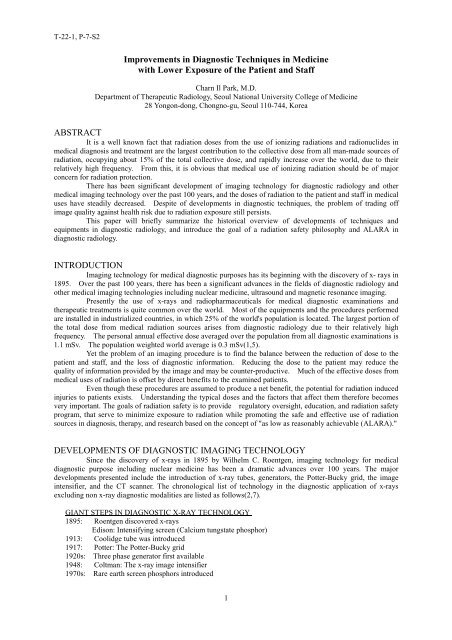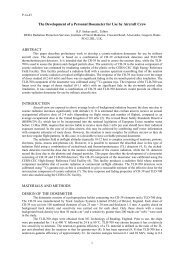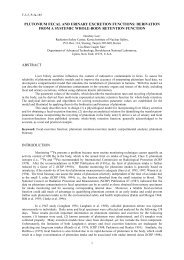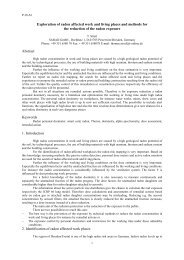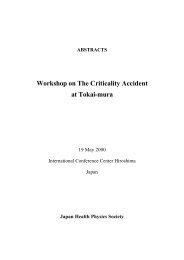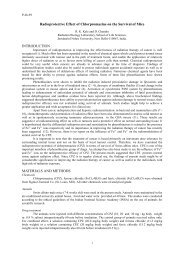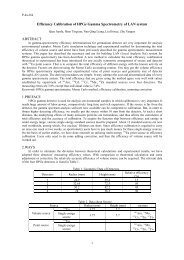Improvements in Diagnostic Techniques in Medicine with Lower ...
Improvements in Diagnostic Techniques in Medicine with Lower ...
Improvements in Diagnostic Techniques in Medicine with Lower ...
You also want an ePaper? Increase the reach of your titles
YUMPU automatically turns print PDFs into web optimized ePapers that Google loves.
T-22-1, P-7-S2<br />
<strong>Improvements</strong> <strong>in</strong> <strong>Diagnostic</strong> <strong>Techniques</strong> <strong>in</strong> Medic<strong>in</strong>e<br />
<strong>with</strong> <strong>Lower</strong> Exposure of the Patient and Staff<br />
Charn Il Park, M.D.<br />
Department of Therapeutic Radiology, Seoul National University College of Medic<strong>in</strong>e<br />
28 Yongon-dong, Chongno-gu, Seoul 110-744, Korea<br />
ABSTRACT<br />
It is a well known fact that radiation doses from the use of ioniz<strong>in</strong>g radiations and radionuclides <strong>in</strong><br />
medical diagnosis and treatment are the largest contribution to the collective dose from all man-made sources of<br />
radiation, occupy<strong>in</strong>g about 15% of the total collective dose, and rapidly <strong>in</strong>crease over the world, due to their<br />
relatively high frequency. From this, it is obvious that medical use of ioniz<strong>in</strong>g radiation should be of major<br />
concern for radiation protection.<br />
There has been significant development of imag<strong>in</strong>g technology for diagnostic radiology and other<br />
medical imag<strong>in</strong>g technology over the past 100 years, and the doses of radiation to the patient and staff <strong>in</strong> medical<br />
uses have steadily decreased. Despite of developments <strong>in</strong> diagnostic techniques, the problem of trad<strong>in</strong>g off<br />
image quality aga<strong>in</strong>st health risk due to radiation exposure still persists.<br />
This paper will briefly summarize the historical overview of developments of techniques and<br />
equipments <strong>in</strong> diagnostic radiology, and <strong>in</strong>troduce the goal of a radiation safety philosophy and ALARA <strong>in</strong><br />
diagnostic radiology.<br />
INTRODUCTION<br />
Imag<strong>in</strong>g technology for medical diagnostic purposes has its beg<strong>in</strong>n<strong>in</strong>g <strong>with</strong> the discovery of x- rays <strong>in</strong><br />
1895. Over the past 100 years, there has been a significant advances <strong>in</strong> the fields of diagnostic radiology and<br />
other medical imag<strong>in</strong>g technologies <strong>in</strong>clud<strong>in</strong>g nuclear medic<strong>in</strong>e, ultrasound and magnetic resonance imag<strong>in</strong>g.<br />
Presently the use of x-rays and radiopharmaceuticals for medical diagnostic exam<strong>in</strong>ations and<br />
therapeutic treatments is quite common over the world. Most of the equipments and the procedures performed<br />
are <strong>in</strong>stalled <strong>in</strong> <strong>in</strong>dustrialized countries, <strong>in</strong> which 25% of the world's population is located. The largest portion of<br />
the total dose from medical radiation sources arises from diagnostic radiology due to their relatively high<br />
frequency. The personal annual effective dose averaged over the population from all diagnostic exam<strong>in</strong>ations is<br />
1.1 mSv. The population weighted world average is 0.3 mSv(1,5).<br />
Yet the problem of an imag<strong>in</strong>g procedure is to f<strong>in</strong>d the balance between the reduction of dose to the<br />
patient and staff, and the loss of diagnostic <strong>in</strong>formation. Reduc<strong>in</strong>g the dose to the patient may reduce the<br />
quality of <strong>in</strong>formation provided by the image and may be counter-productive. Much of the effective doses from<br />
medical uses of radiation is offset by direct benefits to the exam<strong>in</strong>ed patients.<br />
Even though these procedures are assumed to produce a net benefit, the potential for radiation <strong>in</strong>duced<br />
<strong>in</strong>juries to patients exists. Understand<strong>in</strong>g the typical doses and the factors that affect them therefore becomes<br />
very important. The goals of radiation safety is to provide regulatory oversight, education, and radiation safety<br />
program, that serve to m<strong>in</strong>imize exposure to radiation while promot<strong>in</strong>g the safe and effective use of radiation<br />
sources <strong>in</strong> diagnosis, therapy, and research based on the concept of "as low as reasonably achievable (ALARA)."<br />
DEVELOPMENTS OF DIAGNOSTIC IMAGING TECHNOLOGY<br />
S<strong>in</strong>ce the discovery of x-rays <strong>in</strong> 1895 by Wilhelm C. Roentgen, imag<strong>in</strong>g technology for medical<br />
diagnostic purpose <strong>in</strong>clud<strong>in</strong>g nuclear medic<strong>in</strong>e has been a dramatic advances over 100 years. The major<br />
developments presented <strong>in</strong>clude the <strong>in</strong>troduction of x-ray tubes, generators, the Potter-Bucky grid, the image<br />
<strong>in</strong>tensifier, and the CT scanner. The chronological list of technology <strong>in</strong> the diagnostic application of x-rays<br />
exclud<strong>in</strong>g non x-ray diagnostic modalities are listed as follows(2,7).<br />
GIANT STEPS IN DIAGNOSTIC X-RAY TECHNOLOGY<br />
1895: Roentgen discovered x-rays<br />
Edison: Intensify<strong>in</strong>g screen (Calcium tungstate phosphor)<br />
1913: Coolidge tube was <strong>in</strong>troduced<br />
1917: Potter: The Potter-Bucky grid<br />
1920s: Three phase generator first available<br />
1948: Coltman: The x-ray image <strong>in</strong>tensifier<br />
1970s: Rare earth screen phosphors <strong>in</strong>troduced<br />
1
T-22-1, P-7-S2<br />
1971: Hounsfield: First CT scanner<br />
1977: Several groups: Digital substraction angiography<br />
1990s: Slip r<strong>in</strong>g helical CT volume imag<strong>in</strong>g<br />
X-RAY TUBES<br />
The x-ray tube serves the function of creat<strong>in</strong>g x-ray photons from electron energy supplied by the x-<br />
ray generator. The process of creat<strong>in</strong>g the x-ray beam is very <strong>in</strong>efficient, <strong>with</strong> only 1% of the electric energy<br />
converted to x-ray photons and rema<strong>in</strong><strong>in</strong>g 99% of converted to heat <strong>in</strong> the x-ray tube assembly. Thus, to produce<br />
sufficient x-ray output for diagnostic imag<strong>in</strong>g, the x-ray tube must <strong>with</strong>stand and dissipate a substantial heat load,<br />
a requirement that affects the design and composition of the x-ray tube.<br />
A basic understand<strong>in</strong>g of the x-ray tube is important because x-ray beam characteristics substantially<br />
affect spatial resolution, image contrast, and patient dose. The x-ray tube components are the cathode, anode<br />
assemblies, and the tube hous<strong>in</strong>g.<br />
The earliest x-ray tube used by Roengen and others were based upon a design implemented by<br />
Crookes gas tube. But the gas tube performance was unreliable <strong>with</strong> regard to standardiz<strong>in</strong>g the operat<strong>in</strong>g tube<br />
voltage and current for specific exam<strong>in</strong>ation and <strong>in</strong>direct x-rays were generated at the tube wall, which affected<br />
the resolution of x-ray image. A significant breakthrough occurred <strong>with</strong> the development of hot cathode<br />
electron source by Coolidge <strong>in</strong> 1913, which improved reproducibility of exposure output, and high heat load<br />
characteristics of the tungsten. But higher <strong>in</strong>stantaneous x-ray output capabilities coupled <strong>with</strong> the<br />
<strong>in</strong>sufficiency of x-ray production at low energies and consequent heat<strong>in</strong>g of anode soon became a problem for<br />
longevity of the anode target. The implementation of rotat<strong>in</strong>g anode x-ray tube <strong>in</strong> 1929 by Bouwers was the<br />
first significant technological advance of Coolidge tube which <strong>in</strong>creased the heat load<strong>in</strong>g limits of stationary<br />
anode design.<br />
Thereafter, the design of x-ray tubes has been developed to the modern types(3).<br />
X-RAY GENERATORS<br />
The x-ray generator provides the power necessary to produce x-rays <strong>with</strong><strong>in</strong> the x-ray tube, and permits<br />
the selection of x-ray energy, x-ray quantity, and exposure time. The circuit consists of a high-voltage<br />
transformer, rectifiers to change the AC current to DC, and a filament, which produces the current <strong>in</strong> the x-ray<br />
tube. Three-phase generator was <strong>in</strong>troduced <strong>in</strong> 1928 by Siemens. Three- phase circuits (6 pulse) have higher<br />
voltage and higher average current values than s<strong>in</strong>gle-phase (2 pulse) circuits. X-ray production is more<br />
efficient at higher voltages. The higher average voltage of three-phase circuit produce more x-rays per<br />
milliampere that can be obta<strong>in</strong>ed <strong>with</strong> a s<strong>in</strong>gle-phase circuit <strong>with</strong> the same average current. Thereafter, the<br />
design of x-ray generator has developed by several <strong>in</strong>vestigators such as constant potential generators (1960's)<br />
and high-frequency generators (1980's). High-frequency <strong>in</strong>verter generator which has been available for the<br />
past 10-15 years, are becom<strong>in</strong>g the universal choice for diagnostic radiographic systems, which improve the<br />
accuracy of diagnostic exam<strong>in</strong>ations, and protect the x-ray tube and patient(4).<br />
IMAGE QUALITY IMPROVEMENT BY REDUCTION OF SCATTERED X- RAY<br />
1) INTENSIFYING SCREENS.<br />
Intensify<strong>in</strong>g screens convert the <strong>in</strong>visible energy of a x-ray beam <strong>in</strong>to visible light energy. About<br />
99% of the latent image on x-ray film is formed because of this visible light created by <strong>in</strong>tensify<strong>in</strong>g screen.<br />
The process of us<strong>in</strong>g <strong>in</strong>tensify<strong>in</strong>g screens <strong>with</strong> film is especially important <strong>in</strong> diagnostic radiology, where<br />
imag<strong>in</strong>g detail and limit<strong>in</strong>g the dose to the patient is more critical. The phosphor layer is the key to the<br />
conversion power of the <strong>in</strong>tensify<strong>in</strong>g screen. Calcium tungstate phosphor screen was first <strong>in</strong>troduced by Edison<br />
<strong>in</strong> 1986 and over the years, several materials have been used as phosphors. Some of the older materials such as<br />
barium plat<strong>in</strong>ocyanide, z<strong>in</strong>c sulfide, barium lead sulfate, and calcium tungstate have a lower conversion factor.<br />
The newer one, rare earth screen such as gadol<strong>in</strong>ium, lanthanum, and yttrium have a more efficient x-ray-light<br />
conversion factor. The conversion factor for rare earth screens average about 15-20% compared <strong>with</strong> 5% for<br />
calcium tungstate screen. Rare-earth screen achieves a 50% more reduction <strong>in</strong> radiation exposure <strong>with</strong>out a<br />
cl<strong>in</strong>ically important decrease <strong>in</strong> image quality. Rare-earth screen, most conta<strong>in</strong><strong>in</strong>g a gadolonium oxysulfide<br />
compound, are <strong>in</strong> wide use today.<br />
2). GRIDS.<br />
Dur<strong>in</strong>g an exposure, reduc<strong>in</strong>g scatter or secondary radiation is essential to improv<strong>in</strong>g image quality.<br />
Less scatter radiation is produced by restrict<strong>in</strong>g the beam through collimation of x-ray shutter blades.<br />
2
T-22-1, P-7-S2<br />
Collimat<strong>in</strong>g the primary x-ray beam is the first l<strong>in</strong>e of defence <strong>in</strong> controll<strong>in</strong>g unwanted secondary radiation. A<br />
grid absorbs scatter photons as a second l<strong>in</strong>e of defence. A grid is a device placed between the patient and image<br />
receptor to absorb scatter radiation. The primary purpose of grid is to reduce scatter radiation and improve<br />
contrast.<br />
From the earliest radiographs, a significant degradation that reduced the contrast and quality of the<br />
image was caused by scattered radiation.<br />
In the period of 1913 to 1921, the development of Potter-Bucky mov<strong>in</strong>g grid overcame the image<br />
obscur<strong>in</strong>g effects of scattered x-rays, which is still used universally. Focused grid was <strong>in</strong>troduced <strong>in</strong> 1923.<br />
Common designs for grid <strong>in</strong>clude l<strong>in</strong>ear parallel grids, l<strong>in</strong>ear focused grids, and crossed grids. The antiscatter<br />
grid of today have been essentially unchanged for several decades(7).<br />
COMPUTED TOMOGRAPHY<br />
The advent of CT <strong>in</strong> the mid 1970's revolutionized the practice of diagnostic imag<strong>in</strong>g <strong>with</strong> ability to<br />
accurately depict the x-rays attenuation of three dimensional objects <strong>in</strong> computer reconstructed tomographic<br />
slices <strong>with</strong>out superimpos<strong>in</strong>g other anatomy. This, comb<strong>in</strong>ed <strong>with</strong> ability to differentiate tissue contrast<br />
differences not possible <strong>with</strong> conventional radiography has made CT technology the most significant<br />
contribution to diagnostic medic<strong>in</strong>e s<strong>in</strong>ce the discovery of x-rays(2).<br />
MAJOR ADVANCE IN COMPUTED TOMOGRAPHY<br />
1917: Radon: Inversion formula for reconstruction from l<strong>in</strong>e <strong>in</strong>tergrals<br />
1956: Bracewell: Reconstruction <strong>in</strong> solar astronomy radiation imag<strong>in</strong>g<br />
1961: Olderdorf: Reconstruction from transmission data.<br />
1963: Cormack: Demonstration of reconstruction from l<strong>in</strong>e <strong>in</strong>tergrals us<strong>in</strong>g narrow beams.<br />
1971: Hounsfield: First commercial CT scanner<br />
1973: Introduction of fan beam geometry (second generation)<br />
1975: First scanner <strong>with</strong> tube and detector rotation (third generation)<br />
1976: First scanner <strong>with</strong> tube rotation only (fourth generation)<br />
1985: Peschmann et al: High speed CT for angiocardiography<br />
1989: Kalender et al: Spiral CT<br />
RADIATION SAFETY PHILOSOPHY AND ALARA IN DIAGNOSTIC RADIOLOGY<br />
Radiation safety is important <strong>in</strong> diagnostic radiology, not only because of regulatory requirements but<br />
also because of staffs and patients considered. The pervad<strong>in</strong>g philosophy is that of "as low as reasonably<br />
achievable". ALARA also <strong>in</strong>clude the concept of <strong>in</strong>clud<strong>in</strong>g economic and social considerations. In most<br />
environments, radiation safety means m<strong>in</strong>imiz<strong>in</strong>g all radiation exposure to all <strong>in</strong>dividuals; however medical care<br />
presents a unique situation <strong>in</strong> which patients are <strong>in</strong>tentionally irradiated. Protection philosophy requires<br />
consideration of the benefits of the radiation to which a person is exposed. The goal is to perform diagnostic<br />
procedures that optimize both radiation exposure and diagnostic <strong>in</strong>formation.<br />
Patients and staffs must be considered separately: regulatory dose limits for radiation workers do not<br />
apply to medical irradiation received by patients. Therefore, when a radiation worker becomes a patient, only<br />
patient considerations are applicable.<br />
1). CURRENT TRENDS IN OCCUPATIONAL EXPOSURE OF RADIOLOGIC STAFF.<br />
In diagnostic radiology, the ma<strong>in</strong> source of occupational dose is scattered radiation from the patient.<br />
For all procedures, judicious applications of time, distance, and shield<strong>in</strong>g can be reduced exposure dose dur<strong>in</strong>g<br />
all procedures. Appropriate use of <strong>in</strong>cludes collimat<strong>in</strong>g properly, optimiz<strong>in</strong>g beam-on time, m<strong>in</strong>imiz<strong>in</strong>g distances<br />
between image <strong>in</strong>tensifier and patient, ensur<strong>in</strong>g sufficient distance between patients and x-ray tube, and<br />
optimiz<strong>in</strong>g exposure rates for imag<strong>in</strong>g quality and dose.<br />
2). PATIENT DOSES IN DIAGNOSTIC RADIOLOGY.<br />
Because most procedures caus<strong>in</strong>g medical radiation exposures are clearly justified and because the<br />
procedures are usually for the direct benefits of exposed <strong>in</strong>dividuals, less attention has been given to the<br />
optimization of protection <strong>in</strong> medical exposures than <strong>in</strong> most other applications of radiation sources. Therefore,<br />
factors affect<strong>in</strong>g patients dose <strong>in</strong> all x-ray imag<strong>in</strong>g modalities <strong>in</strong>clude beam energy, filtration, collimation, patient<br />
size and imag<strong>in</strong>g process. Although there are no dose limits for patients, medical procedures that use of<br />
radiation must meet the basic pr<strong>in</strong>ciples of protection, that, is, provide a positive net benefit and use an optimal<br />
level of radiation. For example, ma<strong>in</strong>ta<strong>in</strong><strong>in</strong>g the highest peak kilovoltage that provide acceptable image contrast<br />
leads to lower patients dose(8).<br />
3
T-22-1, P-7-S2<br />
Optimization <strong>in</strong> diagnostic radiology <strong>in</strong>volves two aspects: the first is to establish quality assurance<br />
and quality control programs to ensure a proper performance of the x-ray equipment: the second is the necessity<br />
to f<strong>in</strong>d a reasonable compromise between high image quality and low patient dose.<br />
Factors affect<strong>in</strong>g patients dose are<br />
1). basic x-ray/image system parameters (nom<strong>in</strong>al focal spot value, filtration, anti-scatter grid, screenfilm<br />
systems, etc)<br />
2). radiographic techniques (KV, exposure time, focus film distance)<br />
3). reference dose values<br />
4). diagnostic requirements (image criteria and important image details)<br />
Reference or guidance levels for ESDs<br />
Radiograph Reference entrance<br />
surface dose (mGy)<br />
Lumbar sp<strong>in</strong>e AP 10<br />
Lat 30<br />
LSJ 40<br />
Abdomen AP 10<br />
Pelvis AP 10<br />
Chest AP 0.3<br />
Lat 1.5<br />
Skull AP 5<br />
PA 5<br />
Lat 3<br />
*data from the current UK national reference dose(6).<br />
CONCLUSIONS<br />
When used under properly controlled conditions, radiation is a safe and <strong>in</strong>dispensable tool for medical<br />
diagnoses. Proper radiation safety management should ensure that staffs are knowledgeable about typical patient<br />
doses that are imparted <strong>in</strong> each type of radiologic procedures and about the factors that affect these doses.<br />
Typically, reduc<strong>in</strong>g patient dose also reduces dose to staffs. Therefore, perform<strong>in</strong>g optimized procedures is<br />
important aspect of radiation protection <strong>in</strong> diagnostic radiology. By understand<strong>in</strong>g the factors that affect patient<br />
doses, radiological staff can concentrate on reduc<strong>in</strong>g patients and staff doses as low as possible while<br />
creat<strong>in</strong>g diagnostic quality images.<br />
As technology develops, regulations change <strong>with</strong> time. Cont<strong>in</strong>u<strong>in</strong>g education <strong>in</strong> radiation protection is<br />
an important aspect of ma<strong>in</strong>ta<strong>in</strong><strong>in</strong>g personal ALARA policies.<br />
REFERENCES<br />
1. NRC: Health effects of exposure to low levels of ioniz<strong>in</strong>g radiation. BERI V. National Academy Press 1990.<br />
2. Webster EW: X-rays <strong>in</strong> diagnostic radiology. Health physics. 69(5), 610-635, 1995<br />
3. Z<strong>in</strong>k FE: The AAPM/RSNA physics tutorial for residents- x-ray tubes. Radiographs 17(5) 1259-1268, 1997<br />
4. Seibert JA: The AAPM/RSNA physics tutoral for residents – x-ray generators. Radiographs 17, 1533-1557,<br />
1997<br />
5. Hall EJ: Radiobiology for the radiologist, daignostic radiology and nuclear medic<strong>in</strong>e; risk versus benefit, pp<br />
419-452, JP Lipp<strong>in</strong>cott, 1994<br />
6. Bauer B, Corbett RH, Moores BM, et al: Radiation protection dosimetry- reference doses and quality <strong>in</strong><br />
medical imag<strong>in</strong>g. In Wall BF(ed): The historical development of reference doses <strong>in</strong> diagnostic radiology.<br />
80(1-3), 15-29. Nuclear Technology Publish<strong>in</strong>g, 1998.<br />
7. Wash<strong>in</strong>gton CM, Leaver DT: Pr<strong>in</strong>ciples and practice of radiation therapy. In Leaver DT(ed): Introduction<br />
to radiation therapy, pp 157-188. Mosby-Year Book Inc. 1996<br />
8. Zankl M, Panzer PH W: The role and determ<strong>in</strong>ation of patient dose <strong>in</strong> x-ray diagnosis. Proceed<strong>in</strong>gs of<br />
<strong>in</strong>ternational congress of radiation protection, 1: 211-218,1996.<br />
4


